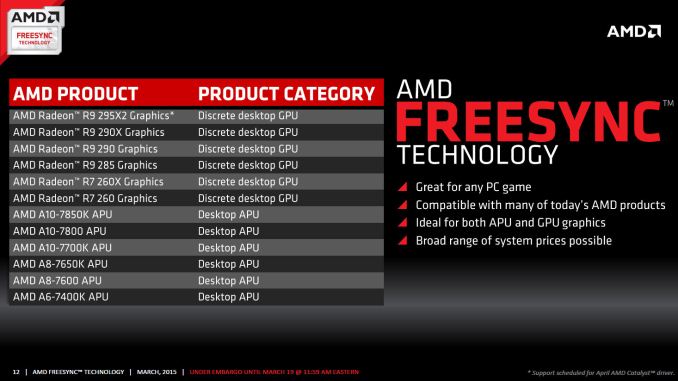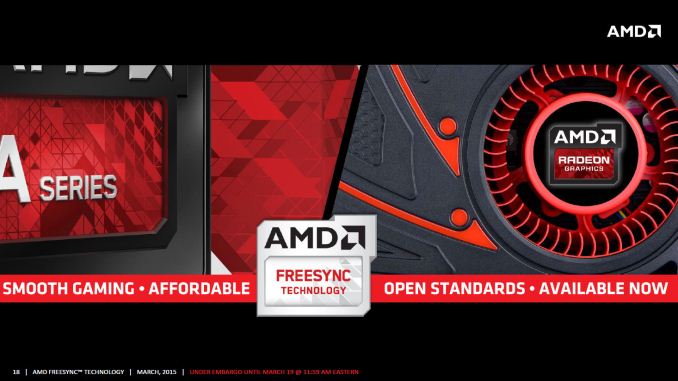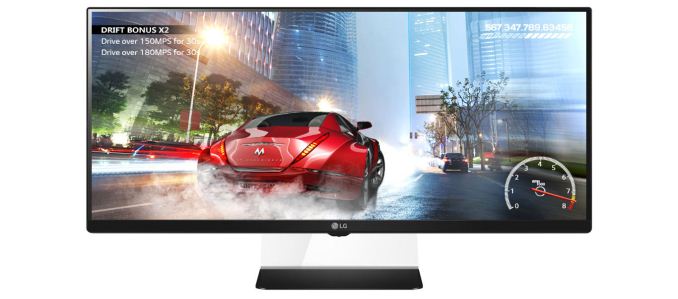The AMD FreeSync Review
by Jarred Walton on March 19, 2015 12:00 PM ESTClosing Thoughts
It took a while to get here, but if the proof is in the eating of the pudding, FreeSync tastes just as good as G-SYNC when it comes to adaptive refresh rates. Within the supported refresh rate range, I found nothing to complain about. Perhaps more importantly, while you’re not getting a “free” monitor upgrade, the current prices of the FreeSync displays are very close to what you’d pay for an equivalent display that doesn’t have adaptive sync. That’s great news, and with the major scaler manufacturers on board with adaptive sync the price disparity should only shrink over time.
The short summary is that FreeSync works just as you’d expect, and at least in our limited testing so far there have been no problems. Which isn’t to say that FreeSync will work with every possible AMD setup right now. As noted last month, the initial FreeSync driver that AMD provided (Catalyst 15.3 Beta 1) only allows FreeSync to work with single GPU configurations. Another driver should be coming next month that will support FreeSync with CrossFire setups.
Besides needing a driver and FreeSync display, you also need a GPU that uses AMD’s GCN 1.1 or later architecture. The list at present consists of the R7 260/260X, R9 285, R9 290/290X/295X2 discrete GPUs, as well as the Kaveri APUs – A6-7400K, A8-7600/7650K, and A10-7700K/7800/7850K. First generation GCN 1.0 cards (HD 7950/7970 or R9 280/280X and similar) are not supported.
All is not sunshine and roses, however. Part of the problem with reviewing something like FreeSync is that we're inherently tied to the hardware we receive, in this case the LG 34UM67 display. Armed with an R9 290X and running at the native resolution, the vast majority of games will run at 48FPS or above even at maximum detail settings, though of course there are exceptions. This means they look and feel smooth. But what happens with more demanding games or with lower performance GPUs? If you're running without VSYNC, you'd get tearing below 48FPS, while with VSYNC you'd get stuttering.
Neither is ideal, but how much this impacts your experience will depend on the game and individual. G-SYNC handles dropping below the minimum FPS more gracefully than FreeSync, though if you're routinely falling below the minimum FreeSync refresh rate we'd argue that you should lower the settings. Mostly what you get with FreeSync/G-SYNC is the ability to have smooth gaming at 40-60 FPS and not just 60+ FPS.
Other sites are reporting ghosting on FreeSync displays, but that's not inherent to the technology. Rather, it's a display specific problem (just as the amount of ghosting on normal LCDs is display specific). Using higher quality panels and hardware designed to reduce/eliminate ghosting is the solution. The FreeSync displays so far appear to not have the same level of anti-ghosting as the currently available G-SYNC panels, which is unfortunate if true. (Note that we've only looked at the LG 34UM67, so we can't report on all the FreeSync displays.) Again, ghosting shouldn't be a FreeSync issue so much as a panel/scaler/firmware problem, so we'll hold off on further commentary until we get to the monitor reviews.
One final topic to address is something that has become more noticeable to me over the past few months. While G-SYNC/FreeSync can make a big difference when frame rates are in the 40~75 FPS range, as you go beyond that point the benefits are a lot less clear. Take the 144Hz ASUS ROG Swift as an example. Even with G-SYNC disabled, the 144Hz refresh rate makes tearing rather difficult to spot, at least in my experience. Considering pixel response times for LCDs are not instantaneous and combine that with the way our human eyes and brain process the world and for all the hype I still think having high refresh rates with VSYNC disabled gets you 98% of the way to the goal of smooth gaming with no noticeable visual artifacts (at least for those of us without superhuman eyesight).
Overall, I’m impressed with what AMD has delivered so far with FreeSync. AMD gamers in particular will want to keep an eye on the new and upcoming FreeSync displays. They may not be the “must have” upgrade right now, but if you’re in the market and the price premium is less than $50, why not get FreeSync? On the other hand, for NVIDIA users things just got more complicated. Assuming you haven’t already jumped on the G-SYNC train, there’s now this question of whether or not NVIDIA will support non-G-SYNC displays that implement DisplayPort’s Adaptive Sync technology. I have little doubt that NVIDIA can support FreeSync panels, but whether they will support them is far less certain. Given the current price premium on G-SYNC displays, it’s probably a good time to sit back and wait a few months to see how things develop.
There is one G-SYNC display that I’m still waiting to see, however: Acer’s 27” 1440p144 IPS (AHVA) XB270HU. It was teased at CES and it could very well be the holy grail of displays. It’s scheduled to launch next month, and official pricing is $799 (with some pre-orders now online at higher prices). We might see a FreeSync variant of the XB270HU as well in the coming months, if not from Acer than likely from some other manufacturer. For those that work with images and movies as well as playing games, IPS/AHVA displays with G-SYNC or FreeSync support are definitely needed.
Wrapping up, if you haven’t upgraded your display in a while, now is a good time to take stock of the various options. IPS and other wide viewing angle displays have come down quite a bit in pricing, and there are overclockable 27” and 30” IPS displays that don’t cost much at all. Unfortunately, if you want a guaranteed high refresh rate, there’s a good chance you’re going to have to settle for TN. The new UltraWide LG displays with 75Hz IPS panels at least deliver a moderate improvement though, and they now come with FreeSync as an added bonus.
Considering a good display can last 5+ years, making a larger investment isn’t a bad idea, but by the same token rushing into a new display isn’t advisable either as you don't want to end up stuck with a "lemon" or a dead technology. Take some time, read the reviews, and then find the display that you will be happy to use for the next half decade. At least by then we should have a better idea of which display technologies will stick around.













350 Comments
View All Comments
Oxford Guy - Friday, March 20, 2015 - link
"Now you want existing displays that are already assembled to be pulled apart and upgraded. That would likely cost more money than just selling the displays at a discount, as they weren't designed to be easily disassembled and upgraded."If that's the case... I wonder why that is? Could it be the blithe acceptance of ridiculous cases of planned obsolescence like this?
Manufacturers piddle out increments of tech constantly to try to keep a carrot on a stick in front of consumers. Just like with games and their DLC nonsense, the new mindset is replace, replace, replace... design the product so it can't be upgraded. Fill up the landfills.
Sorry, but my $800 panel isn't going to just wear out or be obsolete in short order. People who spent even more are likely to say the same thing. And, again, many of these products are still available for purchase right now. The industry is doing consumers a disservice enough by not having standards (incompatible competing G-Sync and FreeSync) but it's far worse to tell people they need to replace otherwise perfectly satisfactory equipment for a minor feature improvement.
You say it's not feasible to make monitors that can be upgraded in a relatively minor way like this. I say it's not. It's not like we're talking about installing DisplayPort into a panel that didn't have it or something along those lines. It's time for the monitor industry to stop spewing out tiny incremental changes and expecting wholesale replacement.
This sort of product and the mindset that accompanies it is optional, not mandatory. Once upon a time things were designed to be upgradable. I suppose the next thing you'll fully endorse are motherboards with the CPUs, RAM, and everything else soldered on (which Apple likes to do) to replace DIY computing... Why not? Think of how much less trouble it will be for everyone.
Oxford Guy - Friday, March 20, 2015 - link
"it's probable that G1 *couldn't* be properly upgraded to support TRIM" "since you were working at Intel's Client SSD department...oh, wait, you weren't." So, I assume I should use the same retort on you with your "probable", eh?Oxford Guy - Friday, March 20, 2015 - link
The other thing you're missing is that Intel never told consumers that TRIM could not be added with a firmware patch. It never provided anyone with an actual concrete justification. It just did what is typical for these companies and for publications like yours = told people to buy the latest shiny to "upgrade".Gunbuster - Thursday, March 19, 2015 - link
So G-Sync has been available to purchase for what a year now? And AMD comes to the table with something exactly the same. How impressive.Oh and Crossfire driver the traditional trust us Coming soon™
chizow - Thursday, March 19, 2015 - link
18 months later, and not exactly the same, still worst. But yes we must give it to AMD, at least they brought something to the table this time.Gigaplex - Friday, March 20, 2015 - link
The troll is strong in this one. You keep repeating how this is technically worse than G-SYNC and have absolutely nothing to back it up. You claim forced V-SYNC is an issue with FreeSync, but it's the other way around - you can't turn V-SYNC off with G-SYNC but you can with FreeSync. You don't address the fact that G-SYNC monitors need the proprietary scaler that doesn't have all the features of FreeSync capable scalers (eg more input ports, OSD functionality). You accuse everyone who refutes your argument with AMD fanboy sentimentality, when you yourself are the obvious NVIDIA fanboy. No doubt you'll accuse me of being an AMD fanboy too. How wrong you are.JarredWalton - Friday, March 20, 2015 - link
Technically the G-SYNC scaler supports an OSD... the options are just more limited as there aren't multiple inputs to support, and I believe NVIDIA doesn't bother with supporting multiple *inaccurate* color modes -- just sRGB and hopefully close to the correct values.chizow - Friday, March 20, 2015 - link
Actually you're wrong again, Vsync is always off, there is a frame cap turned on via driver but that is not Vsync as the GPU is still controlling frame rate.Meanwhile, FreeSync is still clearly tied to Vsync, which is somewhat surprising in its own right since AMD has historically had issues with driver-level Vsync.
I've never once glossed over the fact G-Sync requires proprietary module, because I've clearly stated the price and tech is justified if it is a better solution and as we saw yesterday, it clearly is.
I've also acknowledged that multiple inputs an OSD are amenities that are a bonus, but certainly not over these panels excelling at what they are purchased for. I have 2xU2410 companion panels with TONS of inputs for anything I need beyond gaming.
darkfalz - Thursday, March 19, 2015 - link
I have to give it to AMD here - I was skeptical this could be accomplished without dedicated hardware to buffer the video frames on the display, but they've done it. I still wouldn't buy one of their power hungry video cards but it's good for AMD fans. This is good news for G-Sync owners too as it should drive down the artificially inflated price (partly due to lack of competition, partly due to early adoption premium). After fiddling around with triple buffering and tripe buffering overrides for years (granted, less of a problem on DX10/11 as it seems many modern engines have some form of "free" triple buffering) it's good to go to perfect refresh rates. As a big emulation fan, with many arcade games using various refresh rates from 50 to 65 Hz, these displays are also great. Was input lag tested? AMD don't claim to have Vsync-off like input lag reduction. This would be superb in a laptop where displaying every last frame is important (Optimus provides a sort of "free" triple buffering of its own, but it's not the smoothest and often requires you to set a 60 FPS frame cap).darkfalz - Thursday, March 19, 2015 - link
By G-Sync owners, I Guess I mean NVIDIA fans / prospective G-Sync buyers. G-sync owners (like me) have already paid the premium.